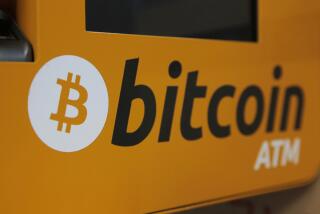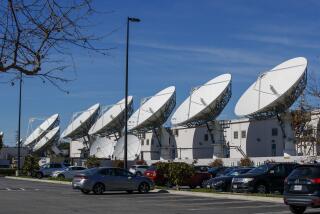The Cutting Edge: COMPUTING / TECHNOLOGY / INNOVATION : This ATM Is Not for Spending but Super-Speed Signal Sending : Telecom: The data transfer system called Asynchronous Transfer Mode is still unproven on a large scale in the real world.
When you cut away all the hype about the information highway, when you look beyond the glitzy interactive movies and games and home shopping services that will travel along it, when you get down to the nuts-and-bolts technology that will actually make it happen, you find yourself staring at something called ATM.
It isn’t a bank machine--though deploying it may yet break a few bank accounts. Nor, as one might expect, is it a well-proven, field-tested communications technology. Rather, Asynchronous Transfer Mode is a cutting-edge transmission technique that makes it possible to send vast quantities of video, voice and computer data over the same circuits at extremely high speeds.
ATM is considered so powerful that it’s likely to be installed in everything from offices and airplanes to cable television systems and public phone networks, forming the communications backbone of everything from massive interactive television systems to modest corporate computer networks.
But there’s one problem: It has not yet been demonstrated that ATM actually works reliably when deployed on a large scale in the real world. And some interactive television pioneers, including Time Warner, are now learning a painful lesson about the gap between promises and reality in the demanding environment of public telecommunications.
ATM is “overhyped and underdeveloped today as a total solution for . . . interactive technologies,” says Jim Barton, chief technology officer of Interactive Digital Solutions, a joint venture between Silicon Graphics Inc. and AT&T.; “We think we have invented an incredible amount of technology and new ways of doing things with ATM. But what we’ve really done is just build the foundation. Now we have to go back and put in the floors and the walls around it.”
In principle, ATM offers crucial advantages over existing technologies: It can handle many different types of data--including video, voice, and computer information--simultaneously; it can move them at very high speeds, and it can readily “switch” the traffic, as the telephone network does with regular voice traffic. There are plenty of solutions available for high-speed, point-to-point communications, but ATM, with its switching capabilities, offers far more flexibility.
ATM networks, like the so-called packet-switched networks that have long been the technology of choice for computer data, operate by breaking streams of information into discrete chunks. The ATM “cells” each contain 53 bytes of information, and they are sent across the network at lightning speed--up to 100 times faster than most data flows on local area networks.
The cells include routing information that tells the network where the data should be sent. At their destination, the cells are reassembled into their original components, ending up as a picture on a TV screen, a phone call or a fax. And this process of disassembly-transmission-reassembly happens so fast that the moving image--or conversation--is not disturbed.
ATM networks can move data at speeds ranging from the standard 10 megabits-per-second of a local area network to as much as 240 times that speed, or 2.4 gigabits per second. Those numbers go a long way toward explaining why so many companies view ATM as a total solution to their data communication needs--and as the key to some novel new applications.
Boeing Corp. is looking at installing an ATM system in airplanes for in-flight entertainment (with significant weight savings achieved by replacing copper cabling to each seat with light-weight fiber optics). The military is examining ATM for use in command-and-control networks on the battlefield. Movie studios are already putting casting portfolios and films into databases which eventually will become available through ATM networks.
Communications and computer equipment vendors--from giants like AT&T; to start-ups such as networking pioneer Ralph Ungermann’s First Virtual Corp.--are racing to provide ATM equipment. Local and long distance telephone companies, in addition to using ATM to make their networks more efficient, will offer ATM as a service for large customers that do not want to buy their own gear.
But it is the cable television industry that will likely prove, for better or worse, whether ATM is truly ready for prime time. Cable companies have a huge investment in copper coaxial cable which brings cable into people’s homes, but their networks are essentially one-way video distribution systems. Now, they want to convert them into sophisticated two-way networks that can offer telephone service and interactive television.
The cable companies must find a way to offer these new digital services while continuing to deliver the high-quality television broadcasts, says David Tennenhouse, associate professor of computer science at Massachusetts Institute of Technology. And they think ATM is the ticket.
“The cable industry is looking at digitizing their transmission to design a new system from scratch,” says Tennenhouse. “ATM looks like it will give them the flexibility to divide their bandwidth into whatever they need, be it voice, video or data.”
But there are problems. ATM is so new that even the basic electronic languages, or protocols, used to communicate between components of an ATM network aren’t yet finalized. Thus, different carriers have created their own, proprietary ATM signaling protocols--which may work to everyone’s detriment in the long run.
Barton points out that the ATM networks now being offered by AT&T; and Sprint are “somewhat primitive.” For example, he says, “ATM service offered on Sprint may not be compatible with ATM service offered on AT&T.;” The ability to place an ATM call across a network composed of multiple carriers is crucial for many customers.
Until a proposed signaling protocol, known as User Network Interface 3.1, is finalized by the ATM Forum, a group of more than 500 computer and communications companies, hooking one ATM switch to another ATM switch across distances will continue to be difficult and costly. And even if everything works right, none of it is cheap: ATM switches cost $150,000 and up, according to Kevin Beagley, an AT&T; spokesman. Costs for publicly available ATM service start at $4,850 per month in California.
In Time Warner’s much-heralded interactive television trial in Orlando, Time Warner and its primary technology supplier, Silicon Graphics, initially met with limited success because the three test homes involved early in the trial weren’t actually using the system the way engineers and designers had anticipated, sources said. A variety of technical problems have delayed the full rollout of the Orlando trial by nearly a year.
In general, the interactive field trials of video on demand using ATM and other technologies have not gone as predicted, says Scott Stein, president of Applied Network Communications, a consulting group based in Silicon Valley.
“Trial users are not ordering nearly the numbers of movies operators had expected. Furthermore, they are continuing to visit their neighborhood video outlets for video rentals,” Stein says. As a result, the ATM networks may not be the most efficient solution.
“ATM suffers from overoptimism in the short run and resultant over-expectations in terms of the net revenues available from the service,” wrote Alan Mosher, a Portland-based consulting writer for BIS Strategic Decisions, in the September edition of 53 Bytes, the official newsletter of the ATM Forum.
Still, many major customers are pressing ahead with ATM deployments. Time Warner insists that its technology is ready. “There was some fine-tuning, but we are totally confident in our system today,” said Tammy Lindsay, communications director for the Orlando project.
ATM: Ready for Prime Time?
ATM (asynchronous transfer mode) networks can carry many different kinds of data--voice phone calls, video and computer information, for example--simultaneously at high speed.
SERVICES:
The various data streams are fed into the ATM switch, where they are broken into small pieces for transmission over high-capacity phone lines. They are then re-assembled at the other end--all in the blink of an eye.
* Interactive shopping
* Videogame server
* Reference server (dictionary, encyclopedia)
* Interactive gambling
* Medical imaging (X-ray, EKG, etc.)
* Video on demand
* Interactive television
Users:
The technology is considered crucial to the implementation of interactive television and a host of other new “information superhighway” services--but some say it isn’t ready yet.
* Schools, colleges
* Motion picture studios
* Homes
* Offices






